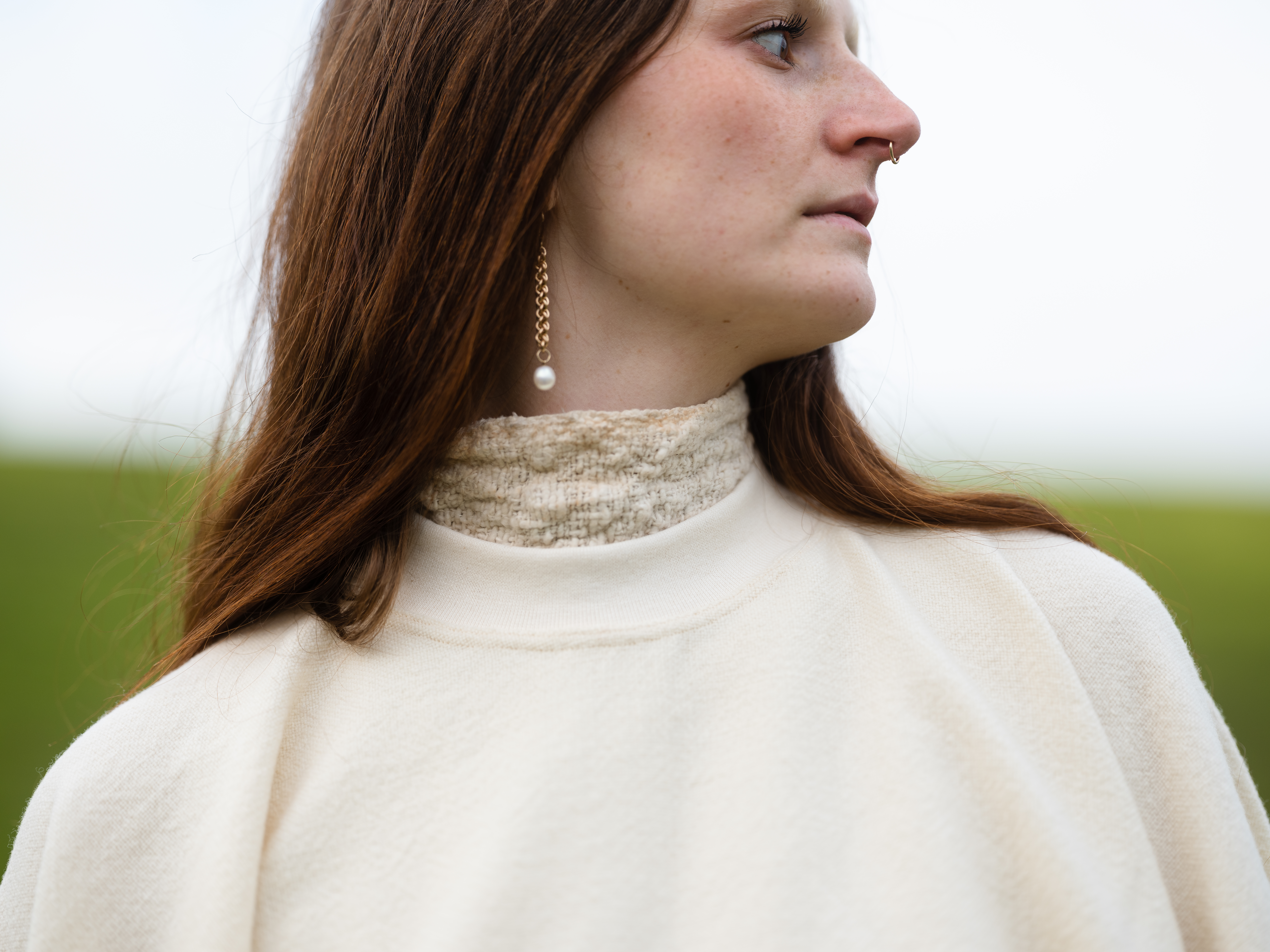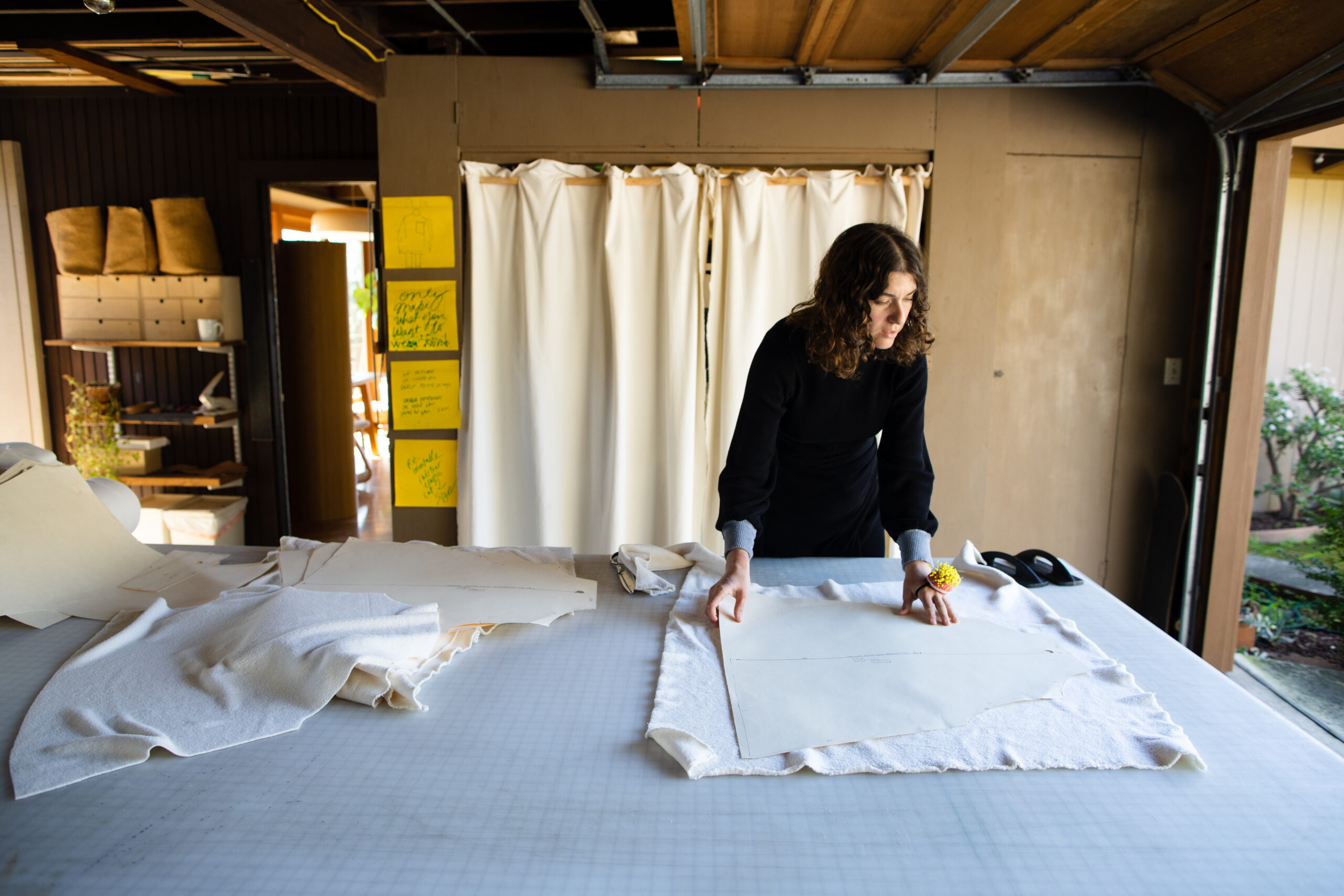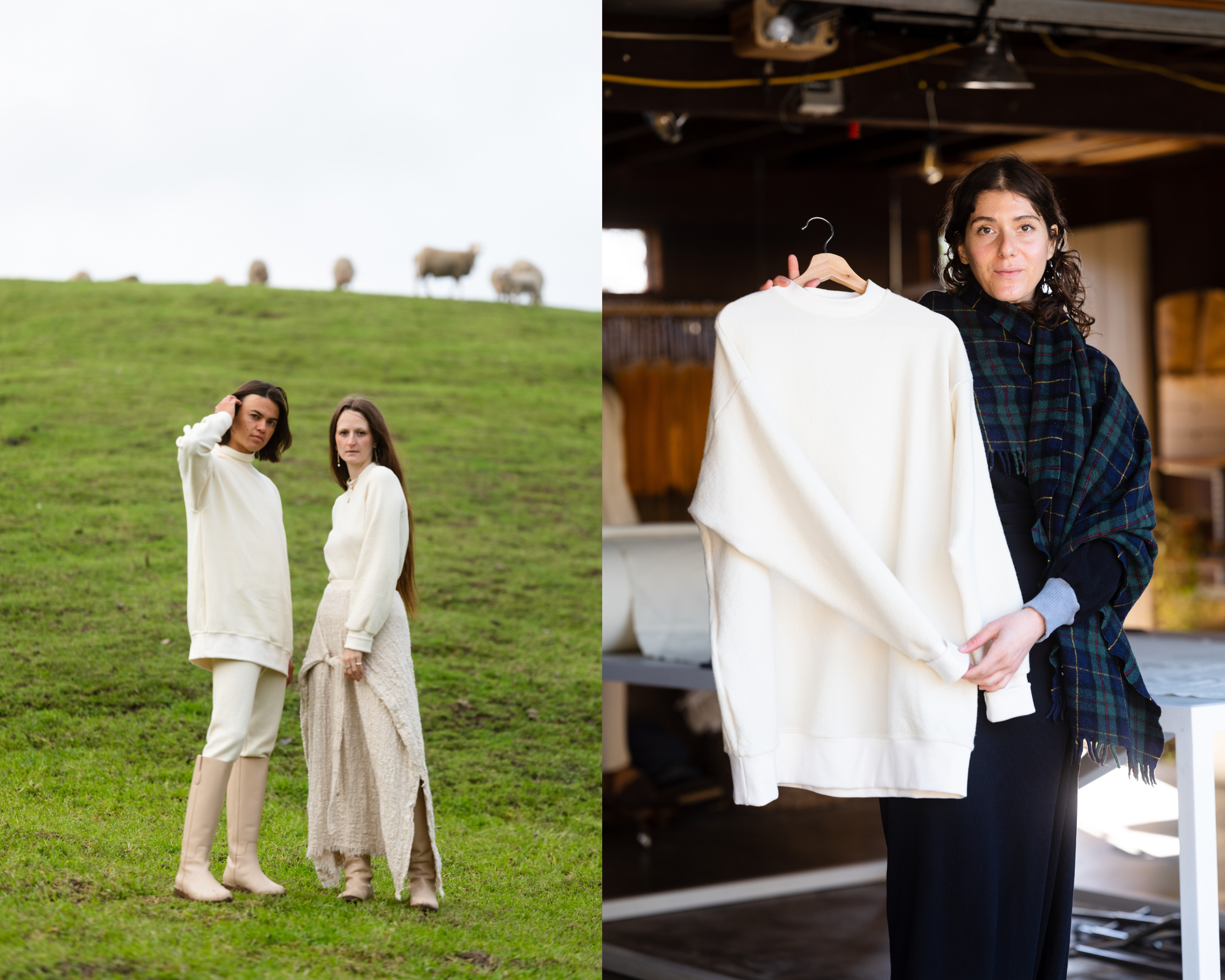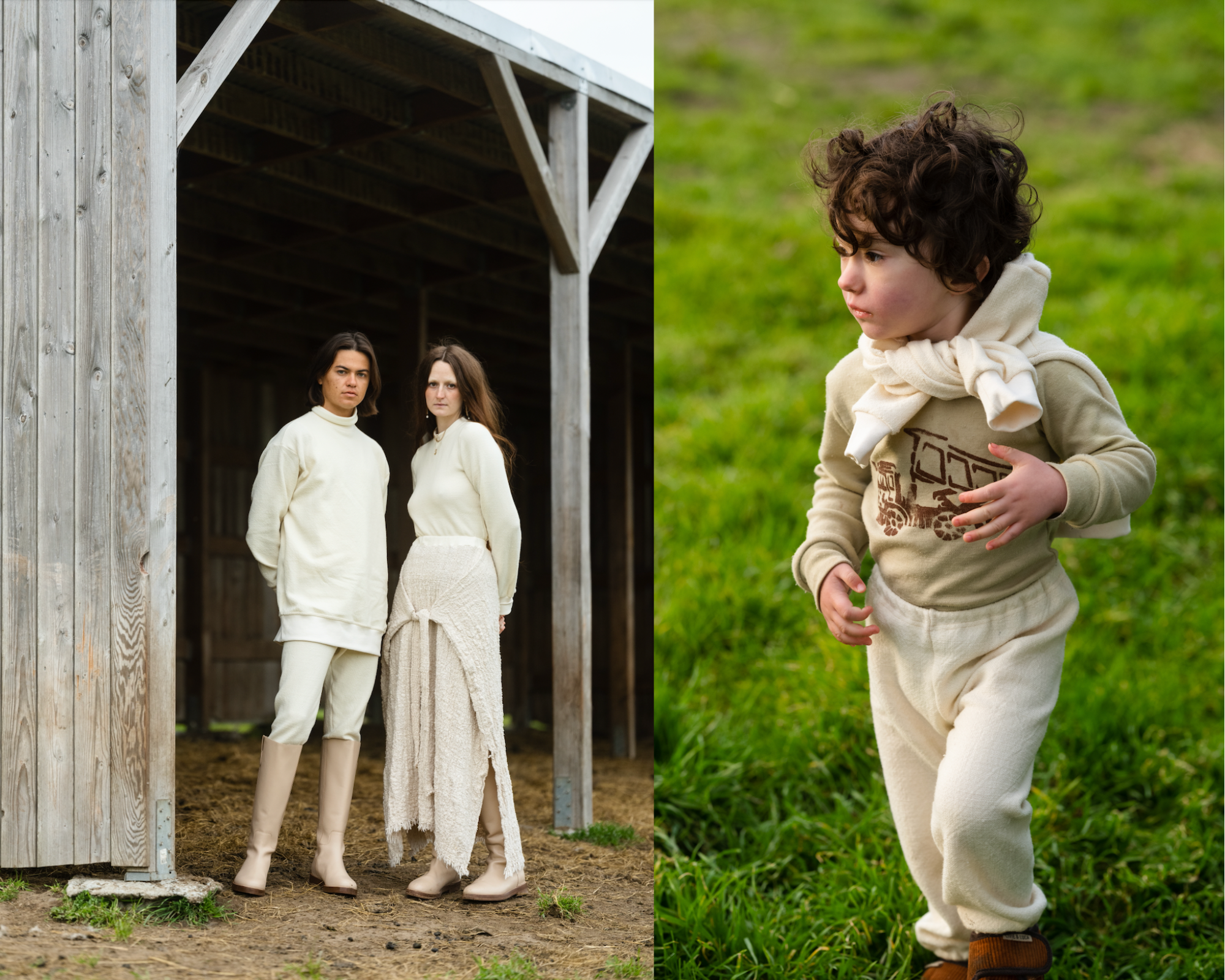
Written by Stephany Wilkes and photographed by Paige Green Photography
Alexandria “Alix” Vasquez of Herderin begins with the body, not the garment.
“What if garment consideration began with asking: Where would you like to be held? Where would you like to have some more support? Feel some weight around your shoulders, or something snug around your low back or abdomen? Could a garment play a role in healing you? Could it feel like wearing a parent’s clothes? What can clothing do for us, emotionally?”
The very idea conveys a sense of relief and, given what humanity has experienced the past several years, feels especially refreshing, relevant, and welcome – as do Herderin garments. Designed, cut, and sewn in San Rafael, California are deliciously nubby, textured, wide-leg pants made for movement. Denim pants get their pleats from wrapping and vary by wearer. An “extra” set of sleeves at the waist of a luscious, cream colored, mid-calf-length dress crosses the front of the abdomen.
“It’s ‘How does a wrap feel?’, not ‘How does it look?’” Alix clarifies. “I want to create a sense of embrace around the body, the emotional frame, not just the physical. How can I comfort areas of the body that feel and store emotions, like hips? The best thing I can do is wrap them in clothing, to support them.”

Alix’s body primacy and thoughtfulness resurrect the priorities that drove the creation of humanity’s first garments: what a particular body needed based on a person’s activities and lived experience, their local climate, land context, and available fibers. It is why we see wool caftans in North Africa, sheepskin coats in Eastern Europe, and why women in many cultures wrap their hips and abdomens tightly after giving birth.
And it perhaps explains why men are finding their way into Herderin’s long merino dress.
“I don’t know how many wear it out of the house,” Alix laughs. “It’s not necessarily about gender but what feels good. Men are slowly waking up to toxic masculinity and how it affects them. They haven’t had clothing options. Men’s bodies and wardrobes are so identified with the kind of work men do for others, like suits, and that is very limiting. Even having the space to wear a flowy pant…It’s not only for martial arts class. Or maybe someone doesn’t always want to wear pants. Men are thinking about sustainability too, so I think they are asking: Given all that, what’s available to me?”
It’s a tension between what’s normal vs. what feels good, which Alix examines in her designs. “Something shifted for me at a conference in Iceland,” she explains. “People had wool blankets and wore them as coats. In the U.S. we see someone do that and think ‘Oh, you must not be dressed,’ but in Iceland, it’s just always been. It’s beautiful, simple, elegant; utmost sophistication. It’s normal. But I know men who won’t wear what they feel most comfortable in because they would stand out. Can we say this is normal now, so they can be comfortable?”

Herderin’s philosophy and values are so far from those of modern fashion that the moniker does not feel like it applies to Alix’s work, and it has always felt that way to Alix, too.
“Fashion was so much not a fit that fashion is what kept me out of the field,” she says. “I didn’t think I fit in fashion, don’t think I fit, because of what it prioritizes. The system of fashion is not working, for the planet or for us. Fashion brands, whether big or small, spend a great deal of energy on design and production, and if this system worked–this standardization–people wouldn’t be so drawn to the alternatives as much as they have been in recent years.”
Garments not working became a personal issue for Alix early on.

“In seventh grade, I was 6’ tall,” she laughs. “It was always clear that clothes would not work for me, as-is. I asked my mom for a sewing machine because I was putting things together with safety pins, and she gave me one.”
More quietly, Alix adds, “My mom was a single parent, so I never got to spend a ton of time with her. I got to spend physical time with my mom by wearing her clothes: they had my mom’s scent, my mom’s energy. It reminded me of being protected. Sleeping in one of her huge shirts…it was the best shirt. Designing from a place of deep physical comfort has been deeply healing for my childhood.”
Alix always wanted to go to school and study design but was so unlike “the fashion kids going to FIDM” that she didn’t. She moved to New York, attended the New School, focused on social justice, and had friends in fashion who dressed to be seen.
“And I didn’t want to be seen,” she says. “What gives someone the right to comment on my body? In New York that was possible, to not be seen, to fade into the scene.”
After graduate school in Richmond, Virginia, Alix landed in Boston, “where I really did not fit in with traditional academia as a PhD student,” she says. Thanks to encouragement from a partner and twin flame, Alix’s interest in the intersection of clothing and emotional experience came into focus. In retrospect, this period looks like a harbinger.

“My partner said, ’You always said you want to make clothes.’ We bid on this vintage Husqvarna sewing machine, won it, and it shipped to the house,” Alix recalls. “And I was not looking back. That was in 2013. The pleasure of not having to shop, and I can just make? I save so much time and life not looking around for things and instead put it into developing skills. Sewing is such a fundamental skill.”
Alix also started a nonprofit based on sociological research she conducted at MIT, on how seeing one’s self in others aided people during emotionally challenging times.
Today, Alix says she feels more like a chef.

“The fabric is the same as food. It’s about sourcing, supporting locals I’ve come to know, using the beautiful harvest, and letting the best ingredients speak for themselves. How much closer can I get? Sense of place is really important to my work.”
Alix continues, “When I lay out fabric on the cutting table, it’s a very important part of my process. It’s where I take the most time. I think about the person it’s for. It’s more like rolling out dough: I want to cut into it as little as possible. I don’t want to manipulate the fabric too much. It took a lot to get here. It’s like a being, as pure as it can be on its own. I want to be responsible, give the fabric honor, use as little manipulation as possible to get to longevity, comfort, emotion.”
Alix recently started working with Climate Beneficial Wool and wants to source fabric from as close as possible, she says, “not because of ‘Buy American!’ or something like that. I’m half Puerto Rican and half Iranian. But because it’s superior stuff. Why go farther? Going local is the only way we can know. I can see the sheep. I know the wool is here. And all you do is shear it! It’s all-seasons wear, it grows every year, it’s gender fluid, it’s for everyone. I live in wool.”

As Alix’s standards have gotten higher, Herderin’s path has admittedly become more challenging in some ways.
“Margins are hard,” she explains. “I can’t do one-thousand-yard minimums, for example. The question becomes, ‘How can I get that, from this farm, at a scale I can afford and work with?’”
But Alix is quick to focus on what matters, and the reward.
“I divorced myself from a productivity-centered mindset. It’s such a kind feeling when someone says ‘I love what you’re wearing’, because of the heart that went into it. The aesthetic is simply the outcome of all the work that came before, of this deeper emotional work: This comforts me. This body is for me. This clothing is for me.”

Herderin creations are available online at Herderin.com. In mid-March 2023, their Climate Beneficial line will be released for current and future stockists, and for anyone who would like to pre-order garments. For updates and information about the release of Herderin’s Climate Beneficial line, signup for their newsletter here.

